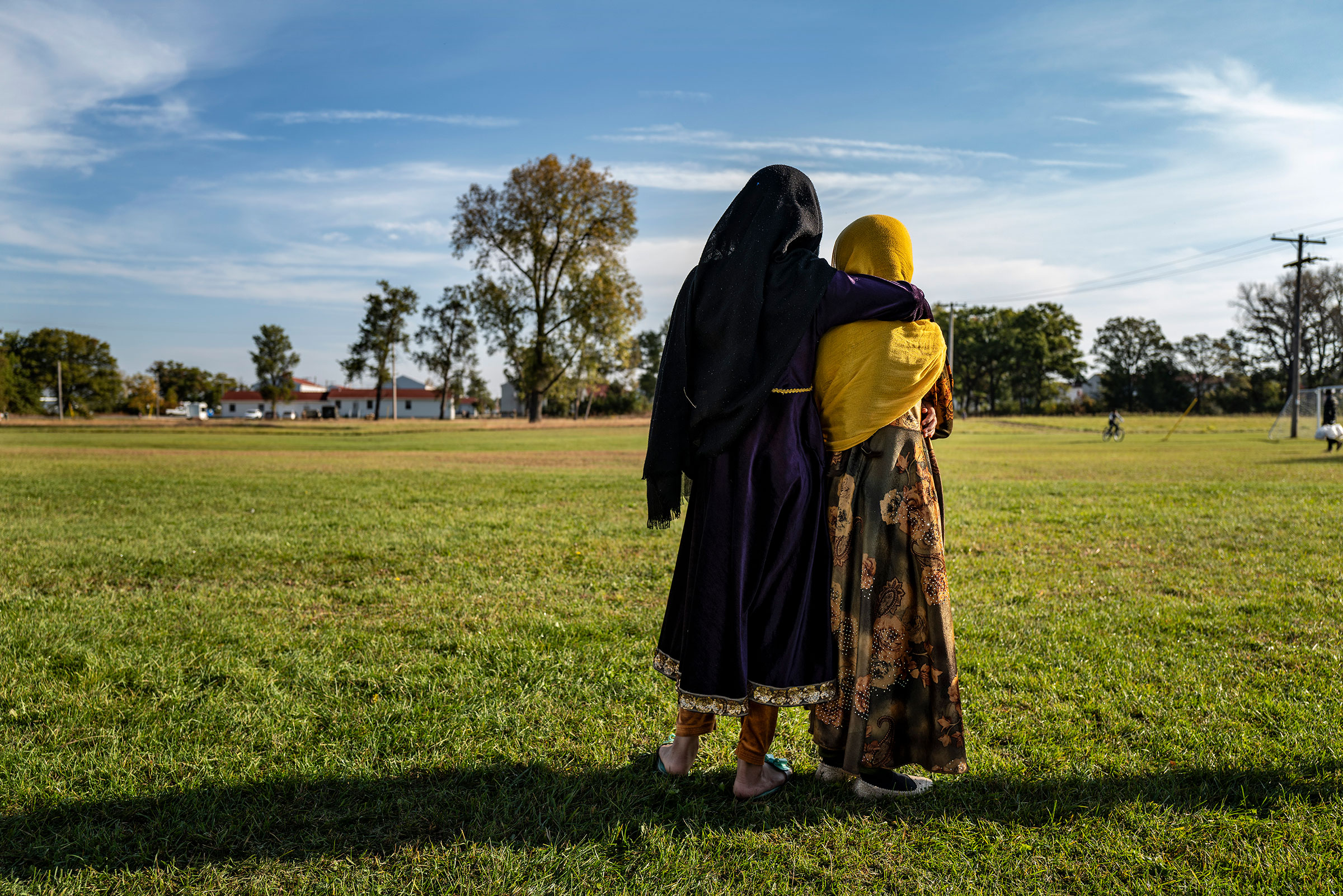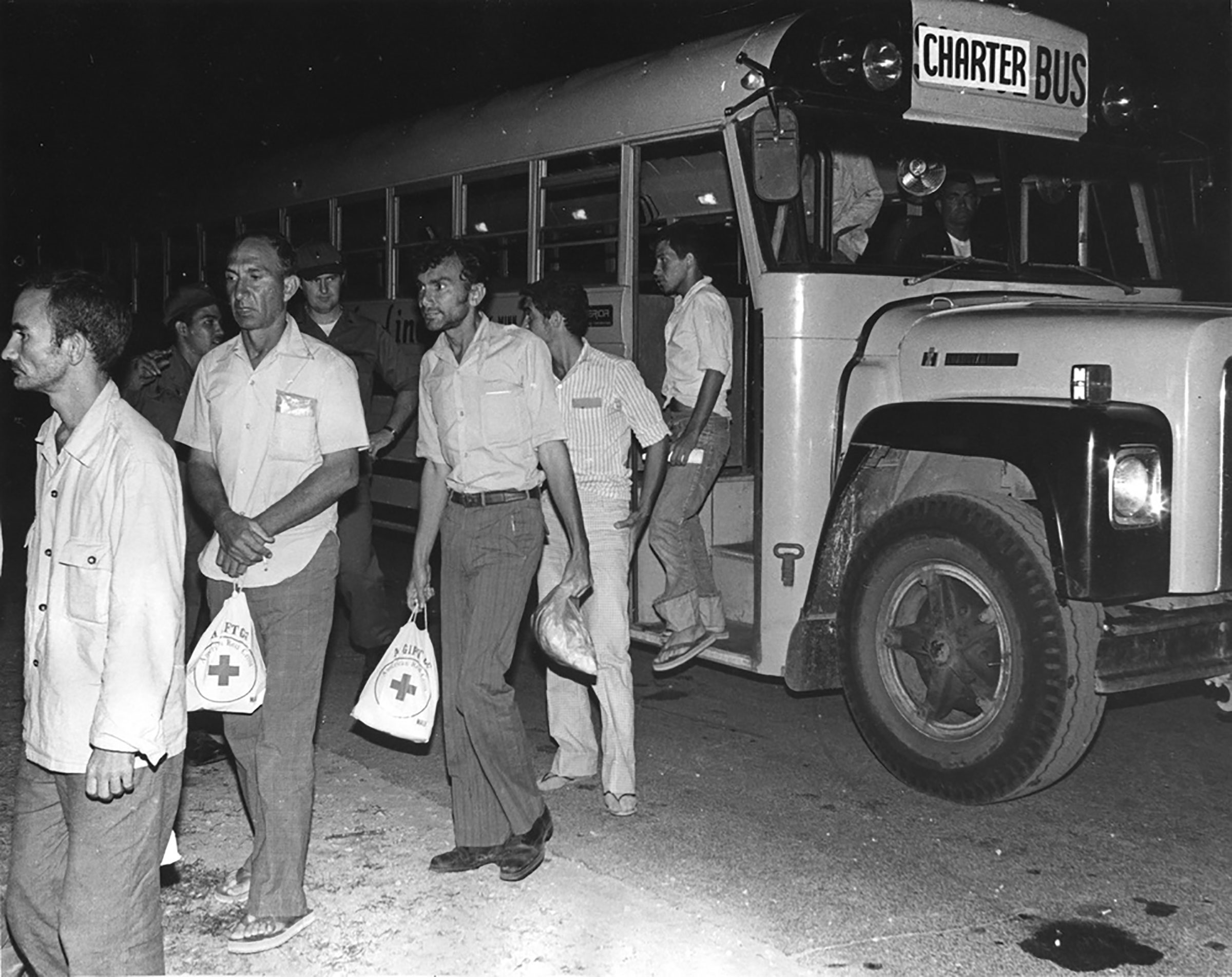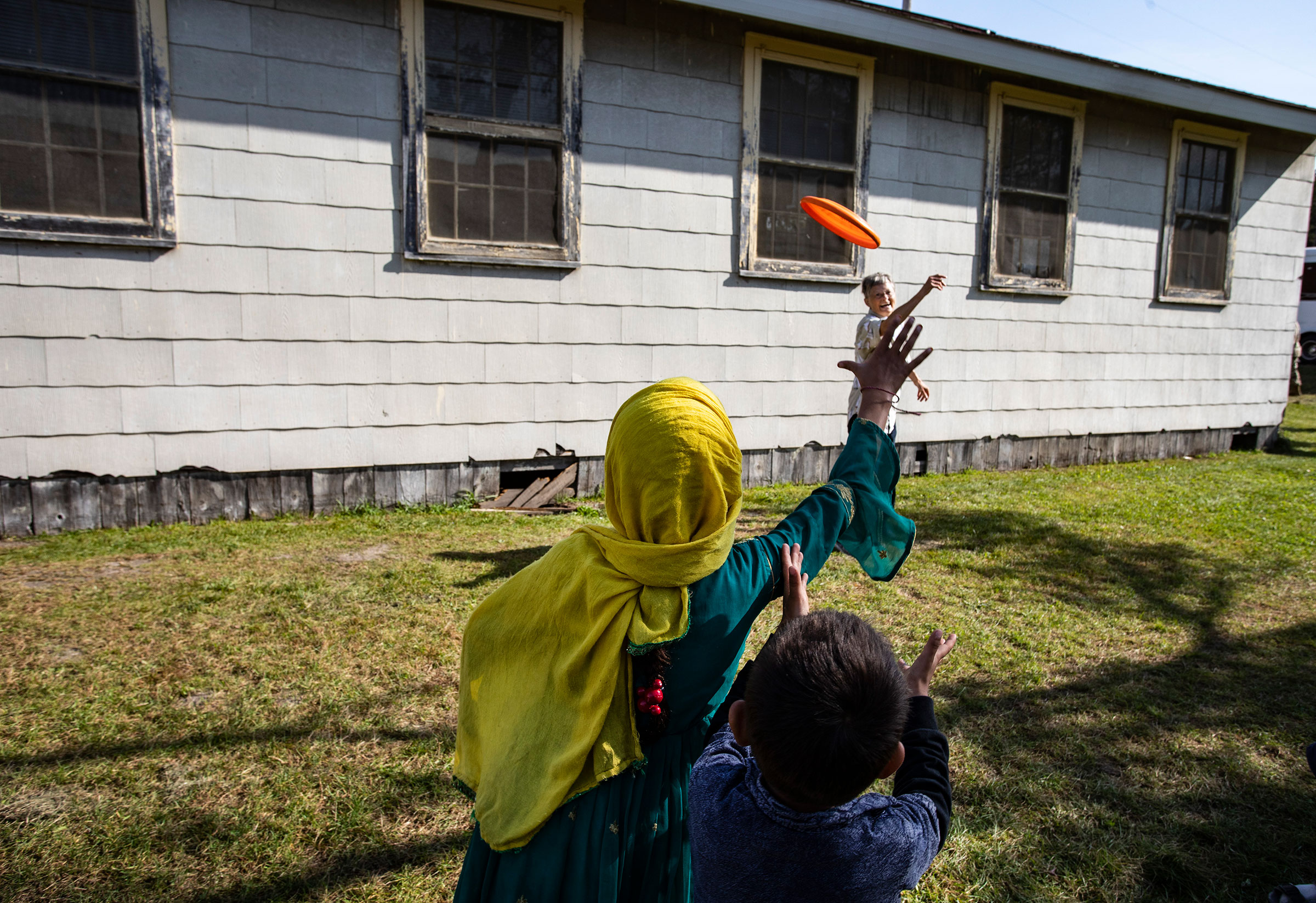
On the last morning of September, dozens of Afghan children cheered on their older brothers as they played a lively game of soccer with U.S. Army soldiers on a military base in rural Wisconsin. As the kids ran up and down the pitch, their traditional long pants and tunics mixed with flashy, donated jackets and sneakers stamped with American logos. Across the field, some of their mothers watched and waved as they hung laundry out to dry.
Fort McCoy, a sprawling Army base surrounded by miles of cornfields and Christmas tree farms, is hosting the largest population of new Afghan evacuees in the U.S. Since the first families arrived in late August, it has grown into a small city of more than 12,600 refugees, almost half of them children, along with thousands more military and support staff. For the Afghans, it has been a blur of government interviews, paperwork, vaccinations, and talking to family left behind when they fled Kabul amid the chaotic U.S. withdrawal.
But by the time a small group of reporters received a tightly-controlled tour on Sept. 30—the first time journalists were allowed onto the base—their surreal new life seemed to be settling into a routine. Afghan families have been sorted into neighborhoods of orderly white barracks, where they are waiting for their immigration paperwork, employment authorizations and health screenings to be processed. Most children seem to have recovered from the initial shock of a sudden, frenzied evacuation that tore them from their homes, according to volunteers. Kids are visible everywhere on the base, high-fiving soldiers, playing outside, and making arts and crafts while their parents learn key phrases in English classes. (“Would you like to pay in cash or card?”) Along with vaccinations, they are being given culturally appropriate clothing and food, military officials say.
Afghans who spoke to TIME were optimistic they would be leaving the base soon for their new lives. “I’m not concerned at all,” says Abdulhadi Pageman, a 44-year-old former Afghan Air Force pilot. “As soon as I’m safe here I will find a job,” he explains in an interview conducted under State Department supervision. “It takes some time…but these are amazing people.”
Yet outside the welcoming bubble of what Task Force McCoy Commander Brig. Gen. Christopher Norrie called this “city of Afghan guests,” there are signs of the struggle to come.
The Biden Administration’s efforts to resettle 95,000 Afghan evacuees by September 2022—53,000 of whom are currently being housed on eight military bases across the U.S.—has become a predictable political flashpoint. A short-term spending bill narrowly passed by Congress last week includes $6.3 billion in aid for Afghan resettlement efforts. Republican lawmakers in Washington had pushed for an amendment to the bill to cut off housing, medical help, food and other aid to Afghan refugees as of March 2023. The proposal, by Sen. Tom Cotton of Arkansas, also sought to cut language attached to the spending bill that would help Afghan refugees obtain drivers licenses and identification cards by waiving the requirement for documentation they may not have.
The same day that U.S. officials were walking reporters through the resettlement efforts at Fort McCoy, former President Donald Trump railed against “unlimited money to random, unscreened, unvetted Afghan nationals.” (U.S. security officials have stressed that all Afghan evacuees had to undergo extensive security screenings before arriving in the country.) The issue has been played up by national conservative news outlets, which had previously criticized Biden for not moving quickly enough to evacuate Afghans who risked their lives by working with U.S. forces. Two criminal incidents at Fort McCoy—one in which a 20-year old man was charged with engaging in sexual acts with a minor, and another in which a 32-year old man was charged with assaulting his wife—went viral on conservative social media.
The result has been a disorienting split-screen. More than seven out of 10 Americans support resettling Afghans who worked with the U.S. government or military, according to a new NPR/Ipsos poll. That support is evident at Fort McCoy, where volunteers unpacked donated jackets and t-shirts on Sept. 30 pinned with little paper messages reading “Welcome to the USA,” “Welcome to safety,” and “We are glad you are here.” Residents near the base have stepped in to help, running donation drives and collecting toys and clothing. On a recent morning, members of a local chapter of Catholic Charities played frisbee with the kids, entertaining them while their parents attended English classes.
Yet as Republican lawmakers seize on the issue of refugee resettlement to push a hardline immigration agenda, the national spotlight on Fort McCoy has fueled rumors and safety fears that are testing the tolerance of some in this western Wisconsin community.

The controversy began before the evacuees started arriving. In an open letter to Wisconsin Gov. Tony Evers on Aug. 20, GOP State Sen. Patrick Testin, whose district includes Fort McCoy, raised alarm about “10,000 to 20,000 potentially unidentified, potentially unvetted, potentially unhealthy people as they pour into rural Wisconsin…from a known terrorist training ground.”
Evers, a Democrat, dismissed these allegations as “dog whistle crap.” U.S. officials have also rejected the notion that any Afghan evacuees are entering the country without the necessary security checks. “These individuals were screened and vetted by intelligence, law enforcement, and counterterrorism professionals from across the U.S. government,” Angie Salazar, the federal coordinator for the Department of Homeland Security at Fort McCoy, told reporters.
But many residents of the surrounding area remain unnerved. The towns of Sparta and Tomah, which flank Fort McCoy on either side, have populations of under 10,000, which are now surpassed by the evacuees on base. “As far as I’m concerned, they don’t belong here,” says area resident Lee O’Neill, who told TIME he threw a flier urging neighbors to be respectful of Afghan culture in the trash. “I haven’t met one person around here that’s happy about it.”
On social media, rumors circulated that refugees were “escaping” from the Army installation, forcing local authorities to respond. “Refugees from Afghanistan are lawfully in our country,” Tomah Police Chief Scott Holum wrote on the department’s Facebook page Sept. 1. “As many of you are aware, there have been several reports through social media regarding activities or sightings of refugees…the Tomah Police Department has not received any reports of criminal activity related to refugees from Afghanistan.”
That post and others became forums for heated online arguments. “There is nothing wrong with having trepidation about Afghans coming to rural Wisconsin,” one man wrote in a Facebook comment on the police page, warning that there could be “sleeper al-Qaeda/ISIS operatives mixed in with the valid refugees.”
Many residents who spoke to TIME did not know that few, if any, of the Afghan refugees at Fort McCoy are expected to be resettled in the immediate area. “When you have around 13,000 people come here from a different country that doesn’t really like you, you would be concerned also,” says Paul Bransted, a former U.S. Army Ranger who lives an hour from the base. “Don’t get me wrong, I’m sure they’re all good people, but when the Trojan horse is on the move there’s going to be a few bad apples that would love to do harm to us.”
Others say this is a minority view. “It’s strange for us to be in the national spotlight, and I think the majority of people here see the publicity we are getting as an opportunity to show off our compassion and hospitality,” says Chelsea Van Gundy of Tomah. “We have some community members who have a lot of fear related to the vetting process, and at first there was not a lot of transparency, which fueled rumors. But once our local law enforcement started briefing the community, it helped calm initial fears and reinforce that these refugees are our guests.”
The local reaction is shaped in part by the past. Many residents still vividly remember the last time the U.S. government used Fort McCoy for its refugee resettlement efforts. In 1980, in the midst of the Cold War, President Jimmy Carter vowed the U.S. would provide an “open heart and open arms to refugees seeking freedom from Communist domination” under Fidel Castro, who had just loosened emigration policies. More than 125,000 Cubans arrived in South Florida in what became known as the Mariel boatlift. Roughly 14,000 of them were flown to an improvised refugee camp at Fort McCoy.

The circumstances were different. The large group of Cubans was mostly young and male, and included political prisoners and dissidents as well as those considered “social undesirables” by the Castro regime. But the scenes on the base looked strikingly similar, according to white-and-black photographs in a local archive: the same rows of white barracks, the same English classes and lines for meals and vaccination. The signs were in Spanish then, instead of Pashto and Dari, and the Cubans played baseball and dominoes instead of soccer. But then as now, news coverage amplified concerns about rising crime and the cost to taxpayers, according to Omar Granados, a professor at the University of Wisconsin-La Crosse.
“They were saying that Castro had basically sent them all over here to infiltrate the U.S., and that everyone should be concerned about violent crime,” says Don Porschien, a 58-year-old retired U.S. Marine who at the time was attending high school in nearby La Crosse. “My dad was on a business trip, so he told me to load up my hunting rifle and keep it handy.”
With little clarity about the immigration process or how long they would be detained, the Cuban refugees grew frustrated. There were reports of fights and extortion on the base. Many tried to escape. “Cubans are inside the compound with no protection afforded them by the U.S. government,” a fact-finding commission ordered by the Wisconsin governor found in September 1980, calling internal security to protect the refugees “nonexistent.”
That experience “looms very large for the people who were living here,” says Jared Roll, the historian for Monroe County, which encompasses Fort McCoy. “Everybody that they saw became a potential criminal and therefore someone dangerous in their backyard.” The initial response to Afghan refugees has been largely supportive, Roll says, but it remains to be seen whether the constant news coverage amplifying security concerns will change that.
U.S. officials have not given a timeline for how long Afghan refugees will be housed at Fort McCoy. The group is largely made up of people who worked with the U.S. government in Afghanistan, including translators, drivers, cooks and Afghan Air Force pilots, as well as others whose jobs put them at risk, like journalists, human-rights advocates and aid workers. There are also family members of American citizens or green card holders. Many there are on humanitarian parole while they wait for their special immigrant visas (SIV) to go through a lengthy 14-step process. For those hoping to be sponsored by family members in the country, the process could take between one to five years.
The open-ended process has driven several hundred refugees to leave the military bases where they’re being housed to join friends and family members already in the U.S., according to a report by Reuters, even though doing so means that they forfeit all federal resettlement benefits and likely complicate their immigration status.

Already there are indications that some evacuees may stay at Fort McCoy longer than they expect. Preparations have already begun for what military officials on the base called the “Winter is coming” planning effort. In a warehouse with large cardboard boxes containing donations, evacuees were being fitted for winter coats and boots. Cold-weather tents have been erected on either side of one of the mess halls to shield people waiting in meal lines once temperatures drop.
Some of the Afghan evacuees who spoke to TIME said that they’ve been following the political debate over their presence. “I never thought of getting out of my country, it all happened all of a sudden,” says Khwaga Ghani, a 30-year-old journalist from Kabul who worked for international media outlets before she had to flee. “I don’t care what anybody says—I’m just thankful for what is happening. The people who were scared for their lives, they are safe now.”
As their future continues to be debated in Washington and on cable news, most Afghan evacuees are focused on more immediate matters. “It’s a lot of bureaucratic things that I’m worried about,” says Sameer Amini, a 36-year-old former program coordinator at the U.S. Embassy, who fled Kabul with his wife and two children. “I’m worried about where I will be settled, how I will travel around because I don’t have a drivers’ license, which offices we have to be in contact with…for medical purposes or for schools for my children.”
Any leftover energy goes into thinking about his parents left behind in Afghanistan, Amini says. “I’m not worried about anything else.”
More from TIME
More Must-Reads from TIME
- Cybersecurity Experts Are Sounding the Alarm on DOGE
- Meet the 2025 Women of the Year
- The Harsh Truth About Disability Inclusion
- Why Do More Young Adults Have Cancer?
- Colman Domingo Leads With Radical Love
- How to Get Better at Doing Things Alone
- Michelle Zauner Stares Down the Darkness
Write to Vera Bergengruen/Fort McCoy, Wis. at vera.bergengruen@time.com